Lantern Slides of the Open Spaces Society
The Open Spaces Society (OSS) was founded in 1865. It is the oldest national society in Britain campaigning for the preservation of commons, public paths, and open spaces. The Society has contributed to saving public access to many of our best-loved landscapes and rights of way across the country.
The Open Spaces Society Collection at The MERL includes over 1,000 lantern slides from the early 20th century. They represent images from many of the landscapes that the OSS helped to save, including long-distance paths, river walkways, ancient woods, and footpaths.
Dr Katrina Navickas, Open Spaces Society Fellow at MERL for 2020-21 , selected 15 lantern slides from the collection. These are grouped into four themes: ancient forests and woods; rural idylls; the intrusion of the modern; and obstruction and trespass. Click on the points on the map to learn more about each slide’s location and its history.
For further reading: view accompanying interpretation or explore the OSS’s lantern slides collection online. Alternatively, find out how to get involved with the Society’s work by visiting the OSS website or by following them on Facebook, Twitter, or Instagram.
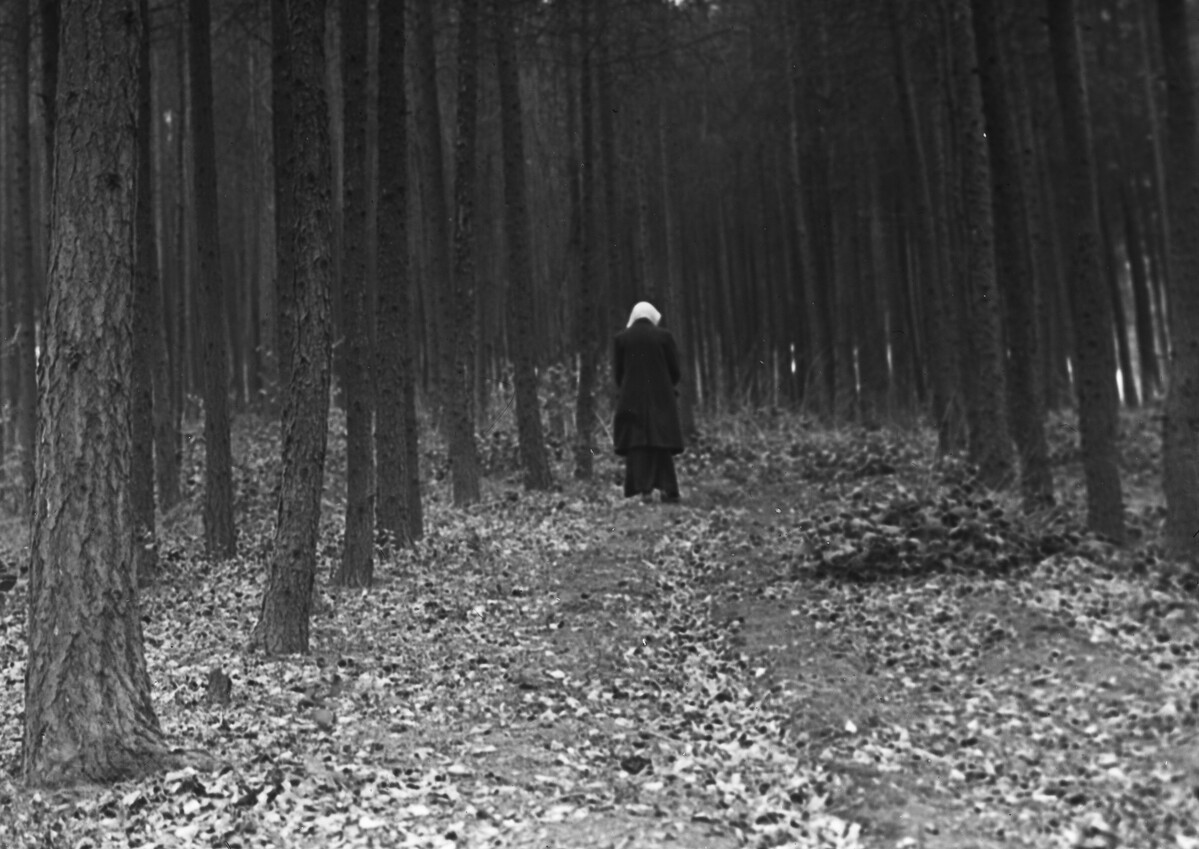
Path through pine wood, West Wycombe
This evocative photograph is most likely located in one of the pine plantations at the top of West Wycombe Hill in Buckinghamshire, situated above the Dashwood family estate. Sir John Dashwood, 10th Baronet, gave West Wycombe hill to the National Trust in 1935, followed by the house and grounds in 1943. The National Trust also acquired West Wycombe village from the Royal Society for the Arts in 1934, who had saved the ancient cottages after it was put up for sale a few years earlier.
The estate grounds had been extensively landscaped in the 18th century. The National Trust is currently undertaking scrub clearance and felling of some of the plantations to establish a grazing regime in line with their downland management plans.
(Map link)
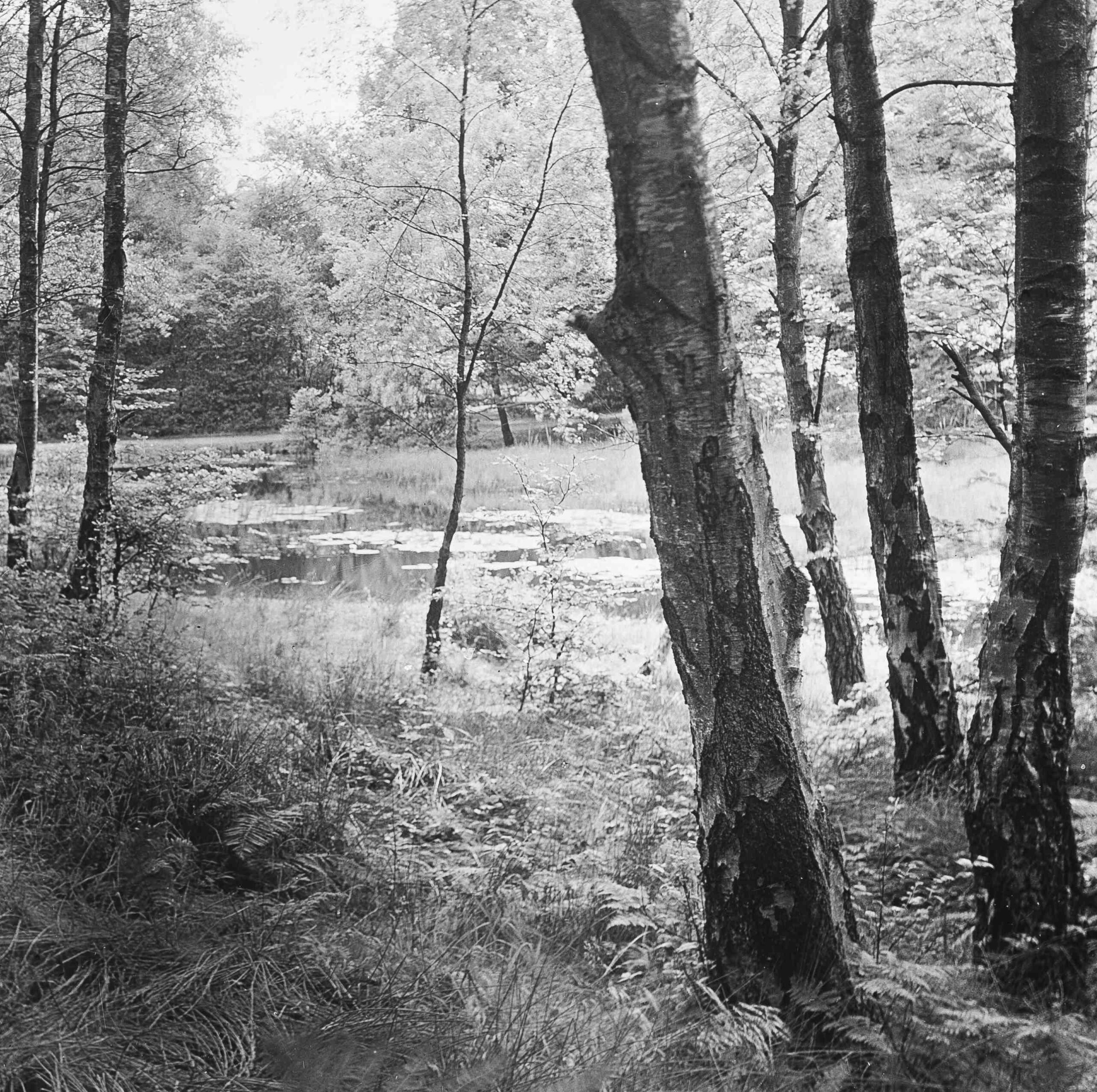
Burnham Beeches
Burnham Beeches in Buckinghamshire is over 900 acres of ancient beech pollards. By the Corporation of London (Open Spaces) Act 1878, the City of London was authorised to acquire land within 25 miles of the City as open space for the recreation and enjoyment of the public. Burnham Beeches was one of the City’s first purchases, bought from the lord of the manor of East Burnham when he sold off his estate and commons in 1879.
It was designated a Site of Special Scientific Interest in 1951 and a National Nature Reserve in 1993. The ancient trees in the woods include huge specimens such as the Druids Oak at over 700 years old. Around 1900, there were around 2000 ancient trees, while today there are under 400 left.
(Map link)
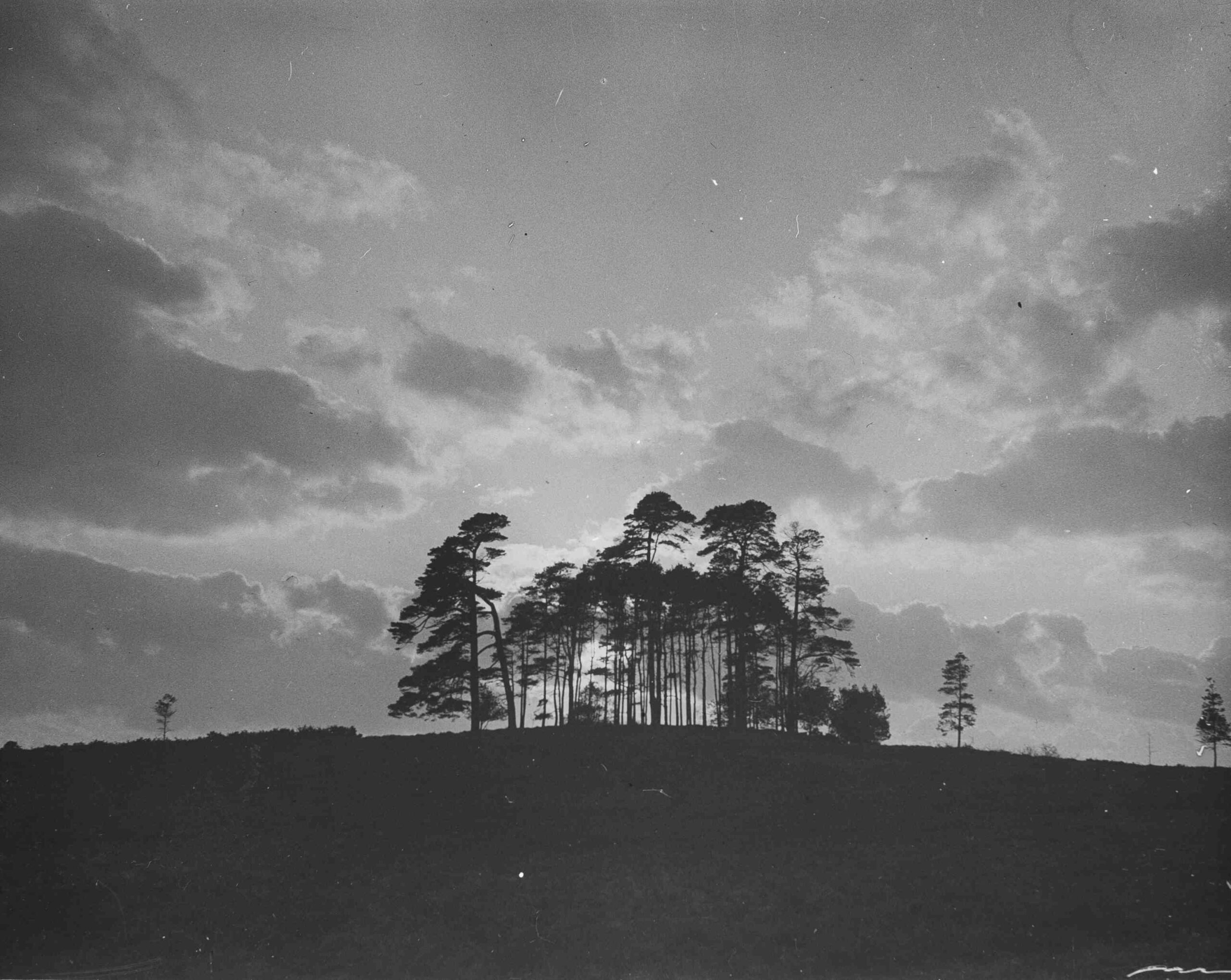
Ashdown Forest
Ashdown Forest in East Sussex was a site of conflict over common rights and set a legal precedent for the commons preservation movement. The area of nearly 14,000 acres is a mixture of forest and heathland. From the early 1870s onwards, the lord of the manor, the 7th Earl de la Warr, began prosecuting local commoners for trespassing on his land. The commoners had customarily been able to gather gorse and birchwood for fuel, and graze their animals. A commoners’ association was formed by a number of wealthy Sussex landowners, and they pursued a counter-action against the Earl for interfering in their common rights. The case went on until 1882, when the opposing groups made a settlement by consent. The Commoners’ Association became a Board of Conservators under an 1885 act of parliament. The Board of Conservators continues to manage the Forest today.
(Map link)
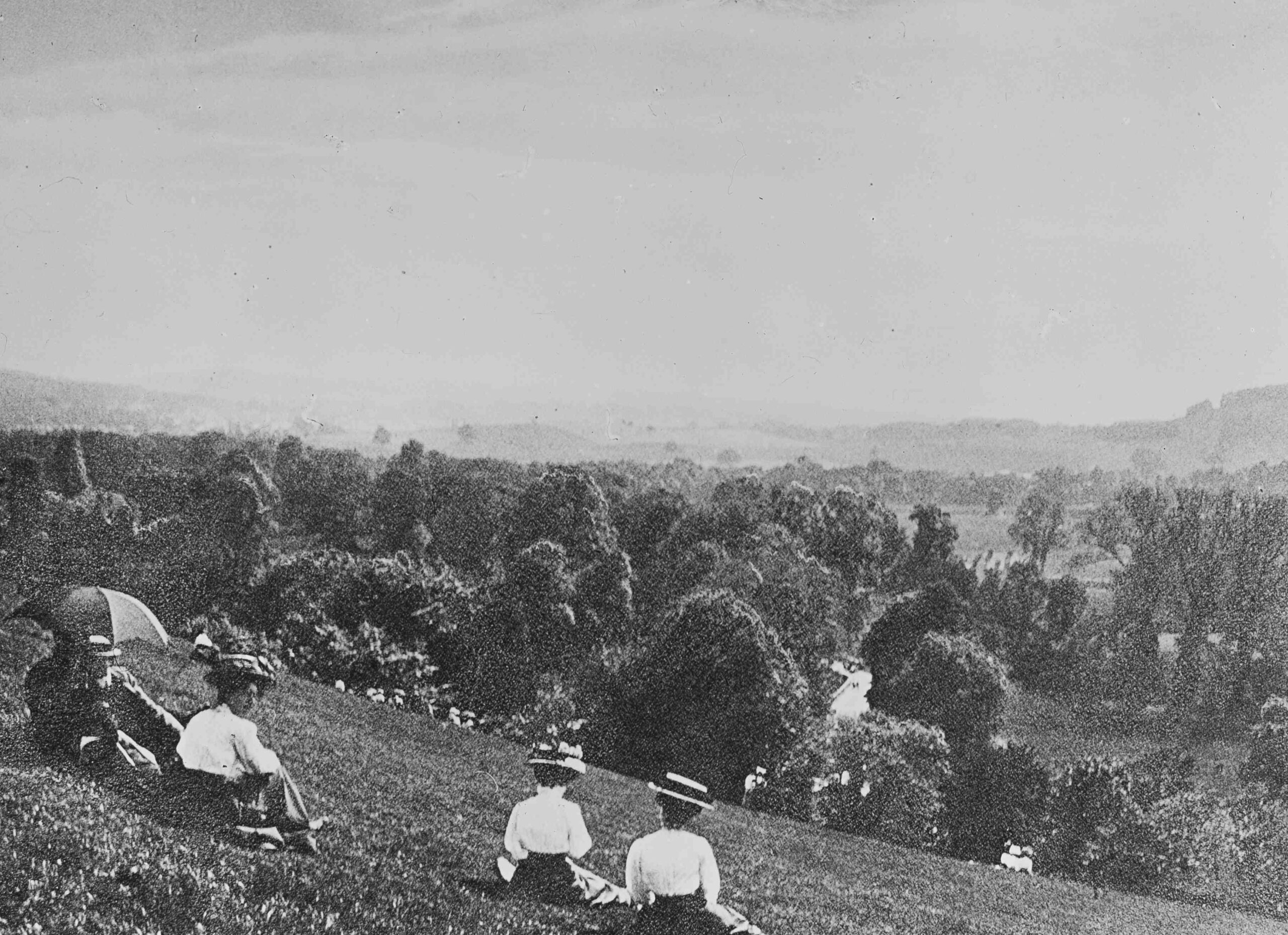
View from Box Hill
Box Hill in Surrey is one of the most familiar landscapes associated with the National Trust and the countryside preservation campaign in the early 20th century. A large number of images in the OSS collection are of Box Hill, the Surrey Hills and the North Downs. This photograph shows Edwardian ladies and men taking in the extensive views eastwards from the slope below what is now Salomons Memorial and the Viewpoint.
Box Hill had already been a popular spot for daytrippers with the coming of the railways in the mid 19th century. Though there were few public rights of way, the various owners of the Deepdene Estate had allowed the public to picnic on the hill. In 1912, rumours arose that the estate were seeking to sell off Box Hill as part of their economic difficulties (leading to their bankruptcy in 1917). This led to a public campaign to save Box Hill as an open space. Together with the OSS (then the Commons and Footpath Preservation Society), the National Trust entered into negotiations about acquiring the land. City financier Leopold Salomons bought Box Hill and donated it to the nation. The National Trust took ownership and management of the 235 acres. It is likely that this image was taken around the time of the campaign to save it.
(Map view)
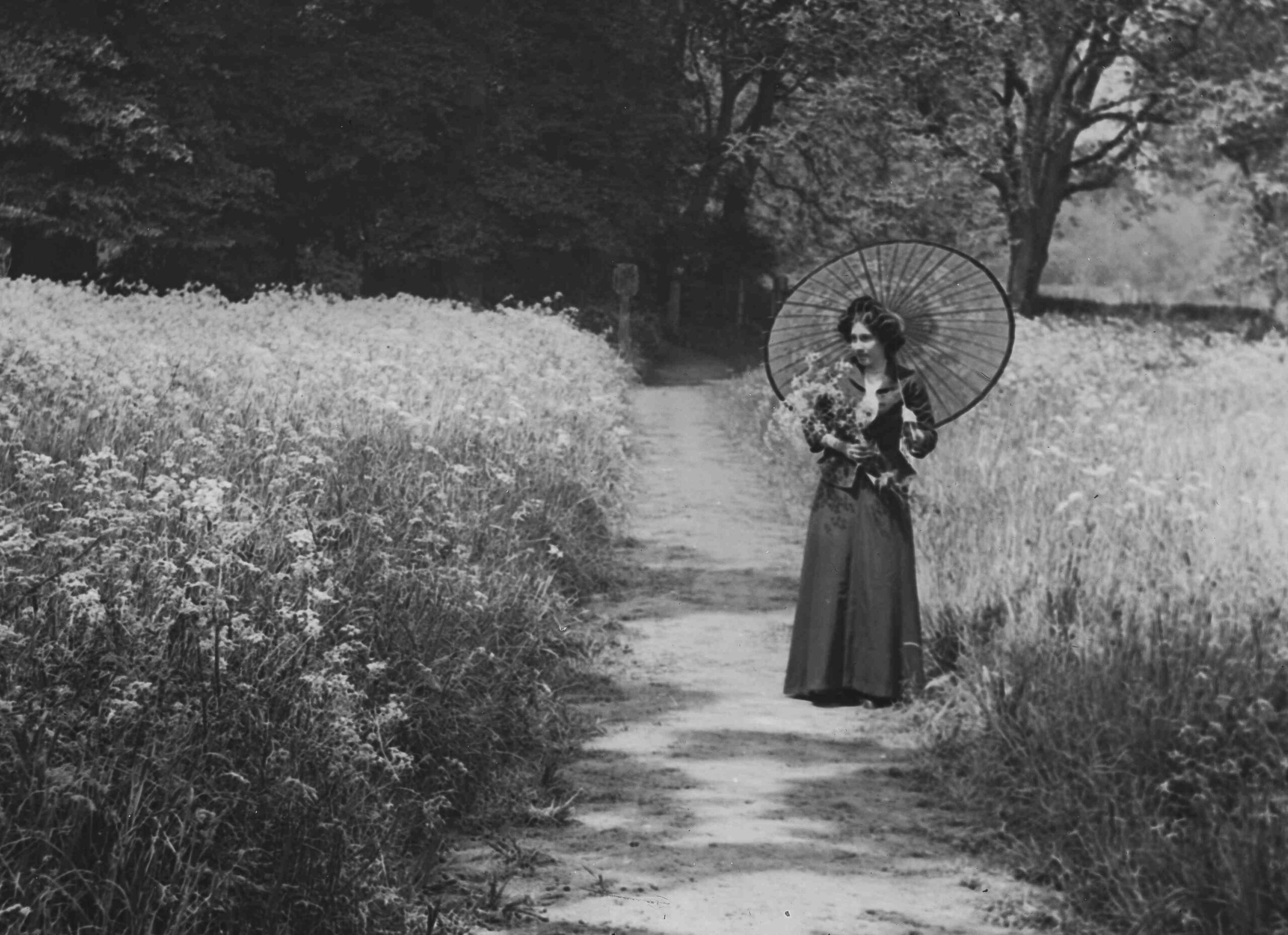
Path at Cookham
This elegant lady is walking along a lane near Cookham Rise and the river Thames, Berkshire. Cookham is a village associated with the English rural idyll idea of the early 20th century, notably as depicted in the paintings of local resident Stanley Spencer. A campaign to save Cookham Commons had been long running since 1900. A fundraising campaign began in the 1920s. In 1934, Maidenhead and Cookham Commons Preservation Committee gave the land to the National Trust.
(Map link)
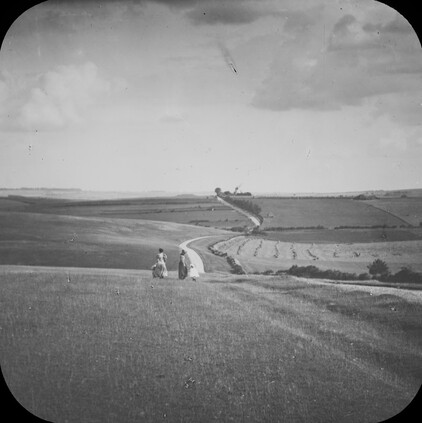
Ilsley Downs
This image of West Ilsley Downs in Berkshire is a classic downland landscape, photographed by Henry Taunt in the 1890s. This type of winding path has been reflected in various iterations of the OSS logo over the years. English Heritage note that the windmill had fallen into disrepair by 1907.
Paul Nash’s 1922 painting, ‘Berkshire Downs’, also depicts the undulating downs and path stretching into the horizon.
The downs by East and West Ilsley villages were used for the sheep/corn system of agriculture, where large sheep flocks were fed by day on the grassland and by night were folded in arable land. The fields were later reorganised in the 20th century. The area is still used for racehorse training. The Berkshire Downs are now part of North Wessex AONB, chalk hills on whose summit is the ancient Ridgeway, a National Trail.
(Map link)
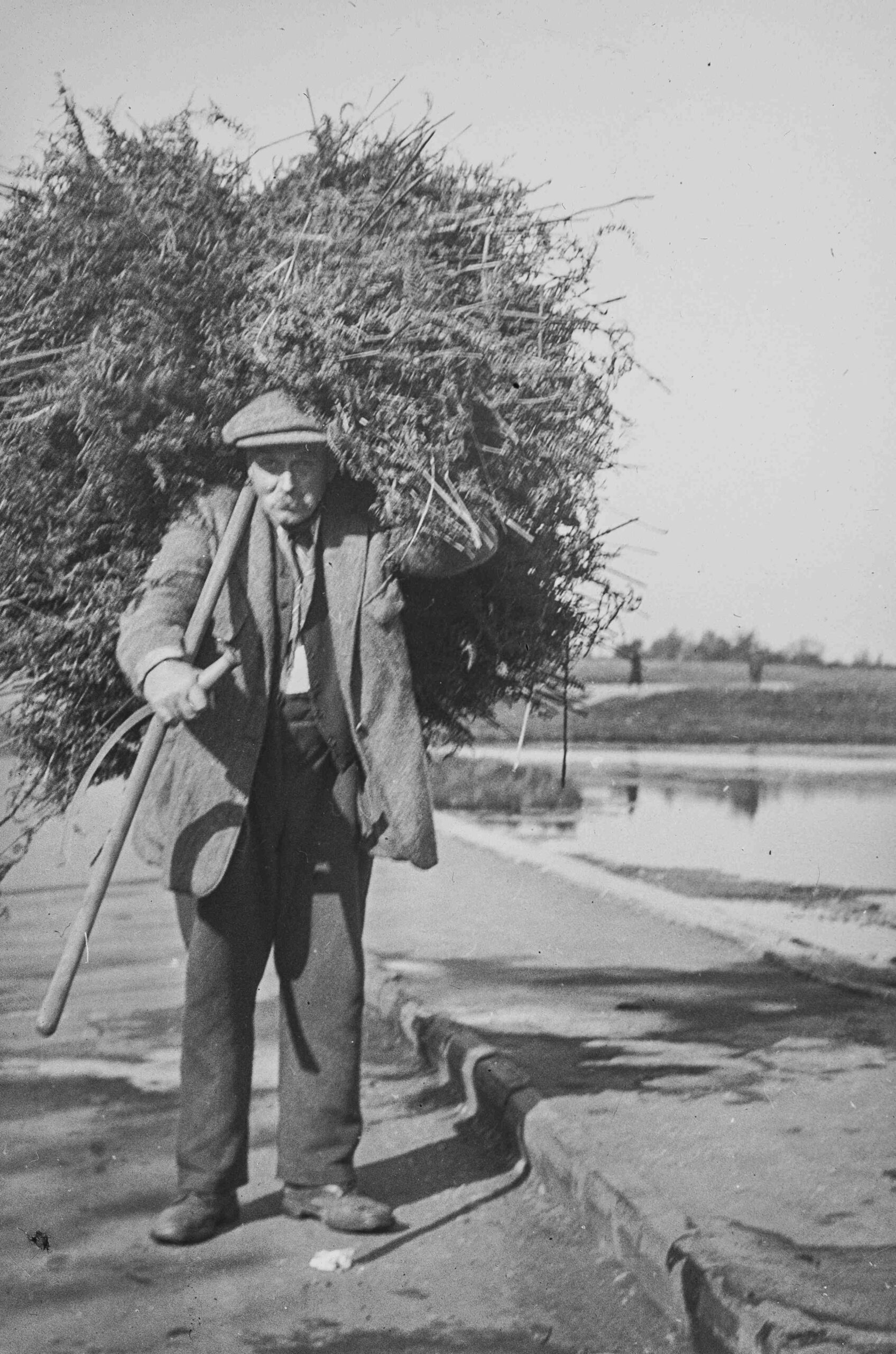
Bracken carrying at Walton Heath
This is one of the few images in the lantern slides collection of a person working.
Walton Heath in Surrey is 500 acres of gorze heath and open land. It was sold with accompanying common rights to the furze, turf, gravel and minerals in 1878. Already by the turn of the century, the area had become suburbanised. A new golf course was laid out in 1904, which became one of the more exclusive clubs in the county. Chancellor of the Exchequer David Lloyd George had a weekend retreat built next to the golf course. In 1913, suffragettes set off a bomb at the house. Emmeline Pankhurst was tried and sentenced to three years’ imprisonment for the act.
(Map link)
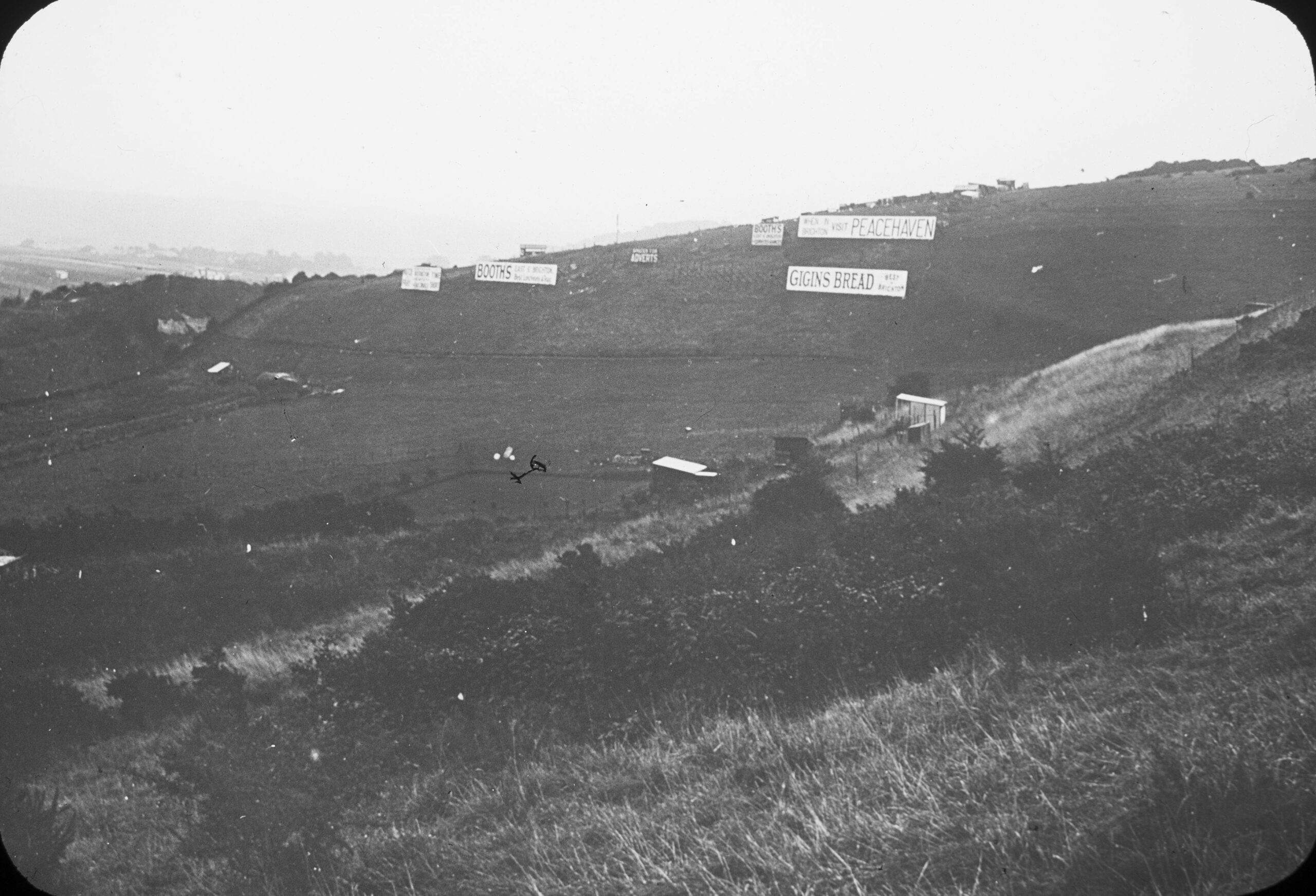
Patcham near Brighton, 1925
The countryside preservation societies regarded advertising billboards as an urban intrusion in rural landscapes. The Society for Checking the Abuses in Public Advertising (SCAPA) was founded in 1893. It later became the Society for the Prevention of Disfigurement in Town and Country: its members included William Morris and Rudyard Kipling. Legislation passed in 1907 and 1925 prohibited adverts along roads, railways and waterways in scenic areas, all villages, and on historic buildings, although much of this was unenforceable.
These advertising hoardings on the edge of the South Downs at Patcham near Brighton led to East Sussex County Council taking their owners to court in February 1925, on the eve of the passage of the new legislation. Five companies, including a cinema and a bakery, were fined for erecting billboards that were up to 170 feet long and 9 feet high. The owner of the land, Thomas Gasson, was fined £5, and £1 for every day that his own billboard remained on the down.
(Map link)
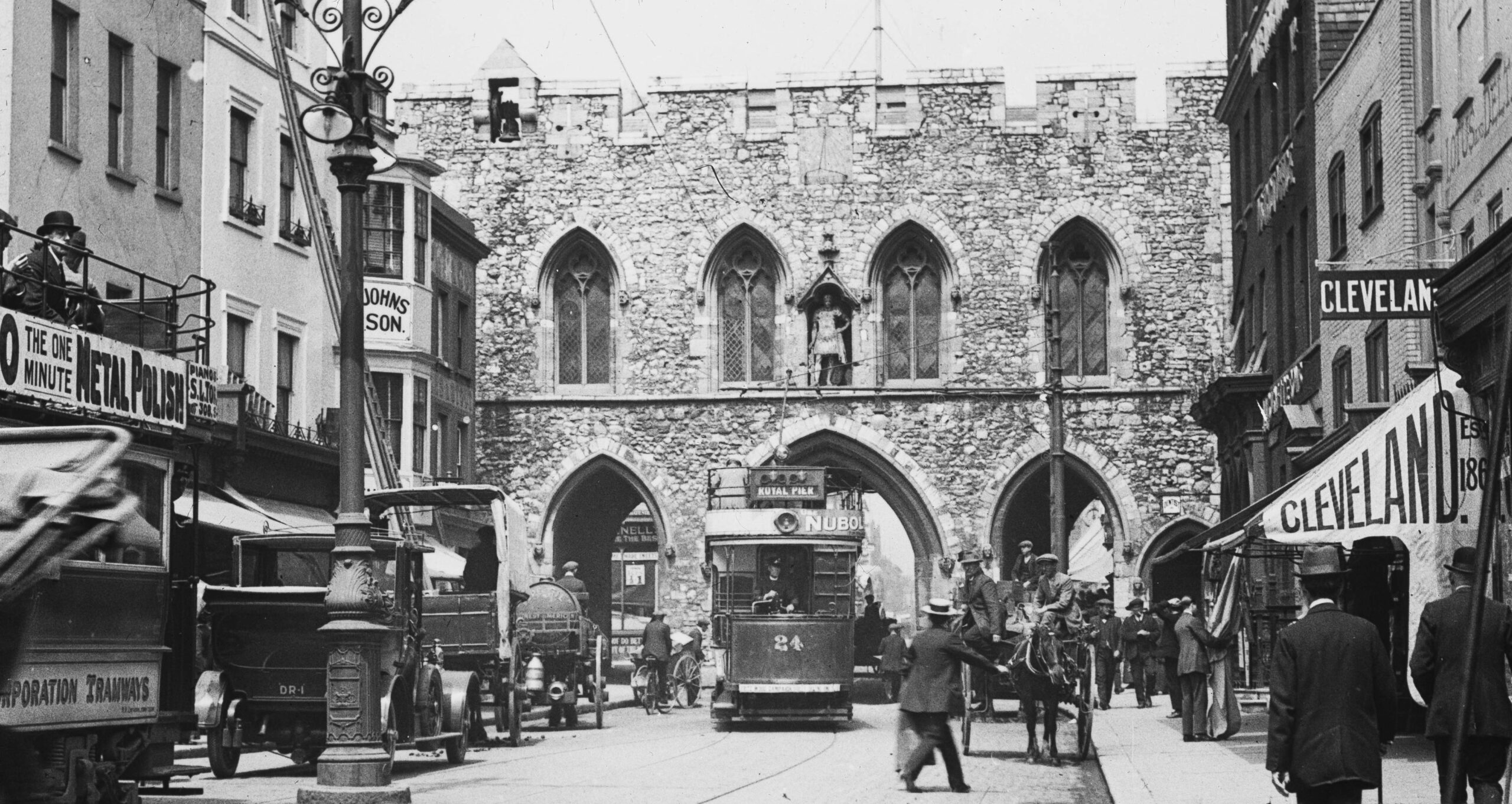
High Street and Bargate, Southampton
Bargate is the oldest section of Southampton’s town walls. It was built as a gateway in c.1180. It had a guildhall on the first floor, and the bell on the top left of this view from High Street was used for curfews and alarms. It is Grade I listed.
By the late 19th century, traffic congestion was a major problem. Coaches and carts, and by the early 20th century, electric trams and motor cars, threatened the medieval heart of the busy port. The council planned to demolish the Bargate in 1899, but the plan was defeated following a high profile public campaign, including a petition signed by members of the Royal Academy and over 3000 ratepayers. The campaign’s legacy did not last long. Further plans for traffic to flow around the Bargate were proposed in 1914 and 1923. It is likely that this photograph is from around 1930, before the sides of the Bargate were finally demolished between 1932 and 1938. Heavy bombing of Southampton during World War Two resulted in further demolitions around Bargate and a very different streetscape.
(Map link)
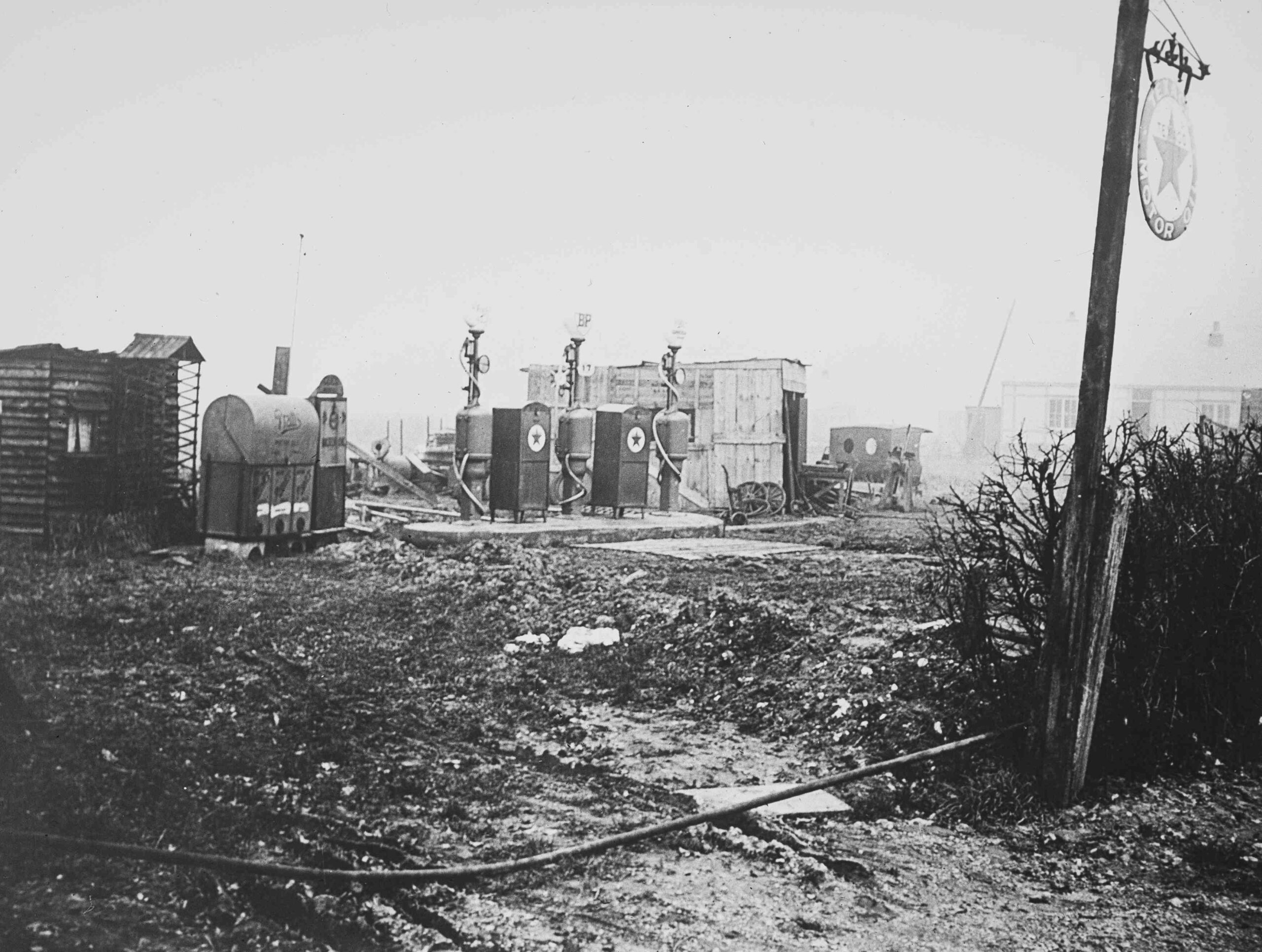
Petrol pumps, Ewell
The arrival of the motorcar changed rural landscapes dramatically. Early motorists had to buy their petrol in small quantities from shops. The first pavement pumps were installed in 1915 but there were no specialised filling stations until the 1920s. The OSS saw petrol stations as ugly additions to the A-roads. The Roads Beautifying Association was formed by the Minister of Transport in 1928 in response to concerns about the impact of motoring on the landscape.
This set of petrol pumps in Ewell in Surrey is likely to have been part of a motor services company run by John Swift from 1919. Swift bought a field at the village end of Reigate Road. His motorcar business used the former cowshed as its premises, and he erected petrol pumps along the side of the field. The area around was being developed as middle-class housing, known as Ewell Downs. The expansion of suburbia necessitated the construction of a new bypass in 1932. Swift sold part of the field to Surrey County Council for the road widening, and the petrol pumps and tanks were moved to a favourable new position along the road. The petrol station is still there off the A24 roundabout.
(Map link)
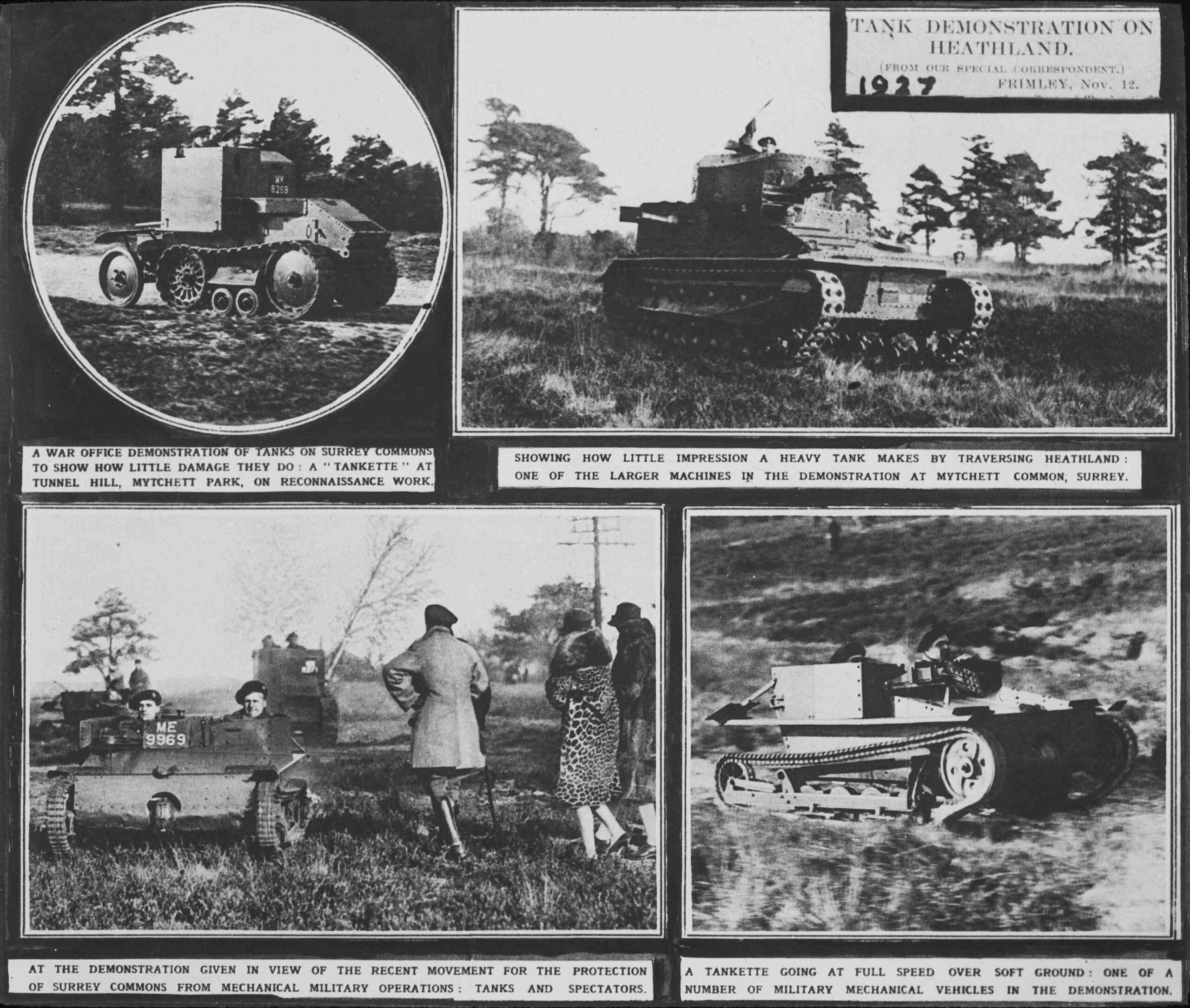
Tank on heathland, Mytchett Park
Military requisitioning of commons and open spaces was not just a feature of the two world wars. The Armed Forces and War Office continued to use substantial areas of land for training grounds in peacetime. In 1927, the War Office planned to acquire 3500 acres of Surrey heathland by compulsory purchase. A public campaign against the scheme was raised by the lords of the manors, common rights holders, former Prime Minister David Lloyd George, and the former War Minister, the Earl of Midleton.
The War Office arranged a tank demonstration on Tunnell Hill, Mytchett Park, on 12 November 1927, in an attempt to allay public fears. The images on the lantern slide are from the Illustrated London News. The scheme was abandoned in early 1928. The War Office agreed a 10 year licence from the lords of the manor to use the commons for a limited number of months per year for military exercises. The public still had access to the commons and heath. Surrey Heath remained a key training ground for the armed forces during the Second World War. Much of the area at Deepcut and Frimley was acquired by the Ministry of Defence for extensive rifle ranges and barracks.
(Map link)
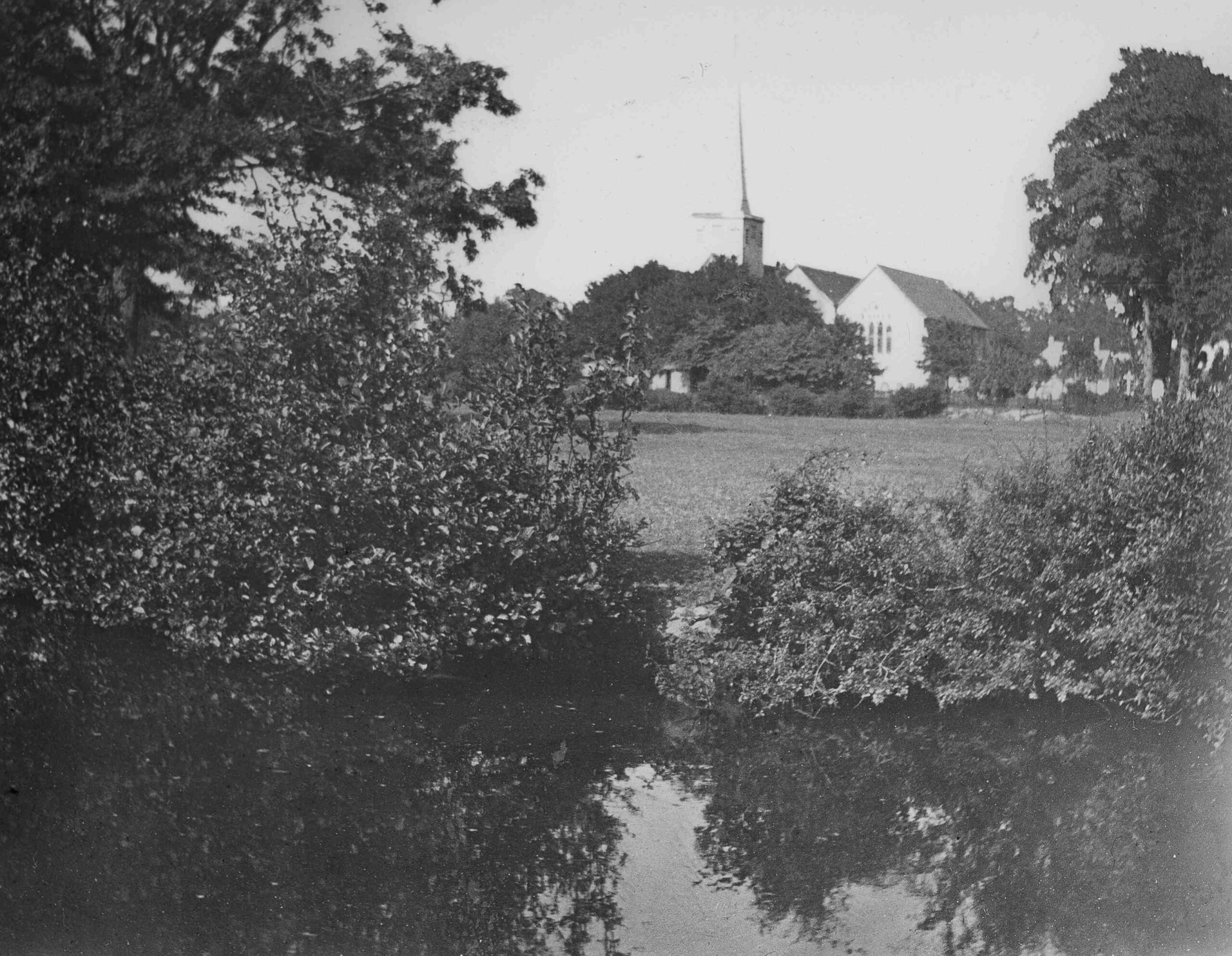
St Bartholomew's Church, Horley
The surroundings of this idyllic looking village scene in Horley, Surrey, have undergone massive change since this lantern slide was taken. St Bartholomew’s, a 14th century church enlarged in 1901, is still there. But just south of the small lake is the northern perimeter of Gatwick airport. The lantern slide image was probably taken around the time that the fields surrounding the Gatwick House estate and racecourse were developed into a private airfield in 1930. Gatwick became a public aerodrome in 1934, with a new terminal building opening in 1936. The aerodrome was requisitioned by the RAF during the Second World War. Gatwick house was demolished in 1950, and Gatwick became London’s second airport in 1958.
(Map link)
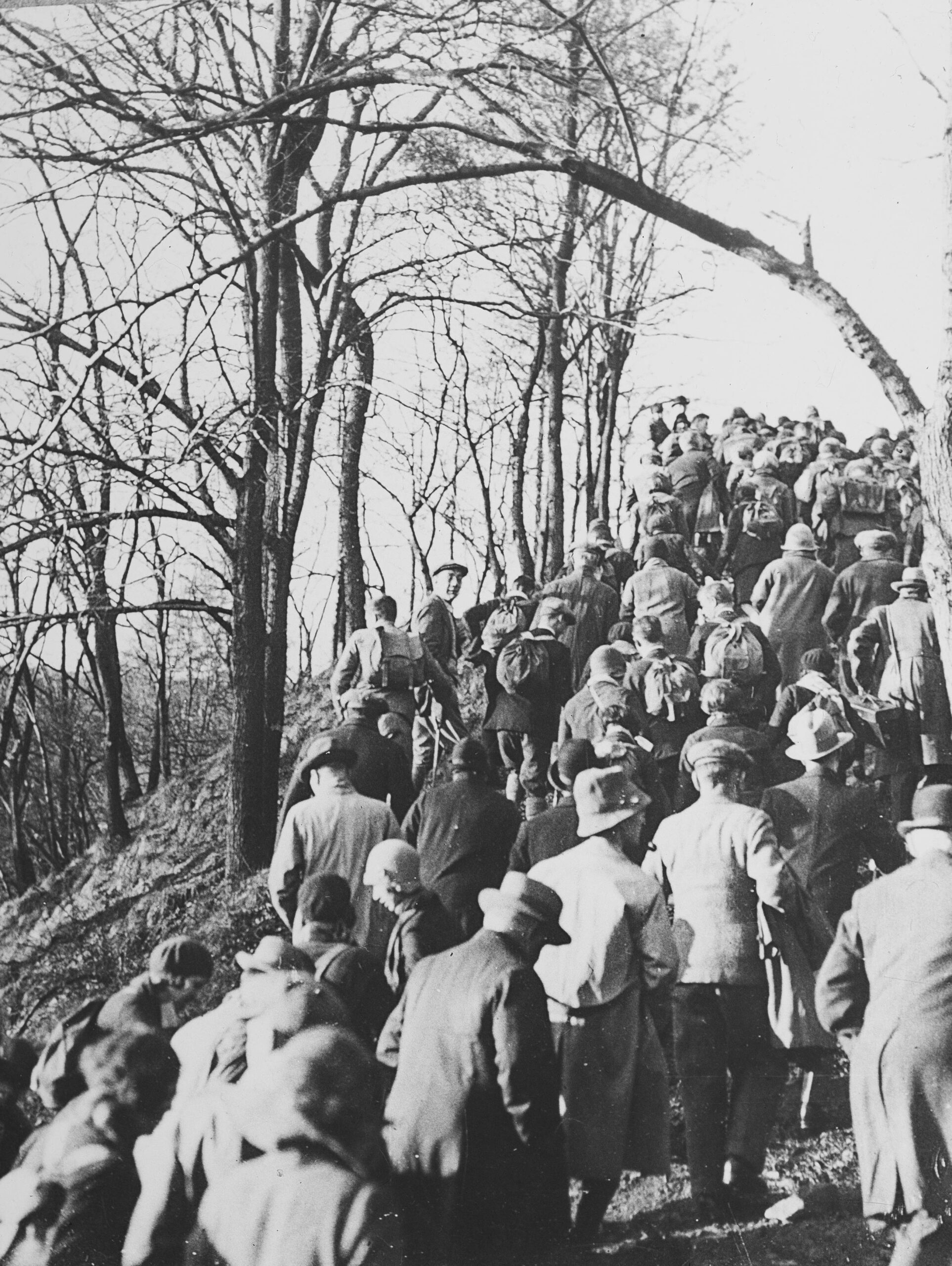
Demonstration at Sunnydale, Bradford
These images are rare, and among only a few capturing the ‘mass trespass’ movement of the 1930s in the lantern slides collection.
The most famous Mass Trespass protest against the removal of rights of way occurred at Kinder Scout in the Peak District, Derbyshire, in 1932. These images of a mass trespass on the moors above Bingley, west Yorkshire, in 1930, importantly show earlier actions defending the right to roam. The Sunnydale gathering ground at East Morton was owned by Bradford Corporation Waterworks, though the reservoir was disused. In 1930, the Waterworks committee closed the site to the public as they intended to let it out for field sports and grazing animals. They also claimed that picnic parties were leaving litter and couples were using the beauty spot for ‘spooning’. The West Riding Ramblers’ Federation denied both claims.
On 16 November 1930, a group of 300 people led by the Ramblers’ Federation trespassed across the estate in protest. Many of these mass trespass actions had an immediate impact, though the tactic was not fully supported by all ramblers.
(Map link)

A barrier removed, Snettisham
The OSS has always been active in challenging obstructions and barriers put up across public rights of way. This image of a man triumphantly standing in a gap in a fence erected across a right of way at Ken Hill in Snettisham, Norfolk, shows the conclusion of a case that went to the High Court in 1901.
Landowner Sir Edward Green had first stopped up the right of way in 1885, in order to stop people accessing the estate to dig gravel and cut firewood. Asserting that their customary rights were being denied, local people took direct action and pulled down the barriers three times. Re-erecting the fences in 1900, Green and his son sued an individual for trespass. The High Court ruled in favour of the villagers, and the decision was greeted with a procession led by the parish council. The Commons and Footpaths Preservation Society supported the case, and secured a precedent that county councils should contribute towards the expenses of rights of way litigation.
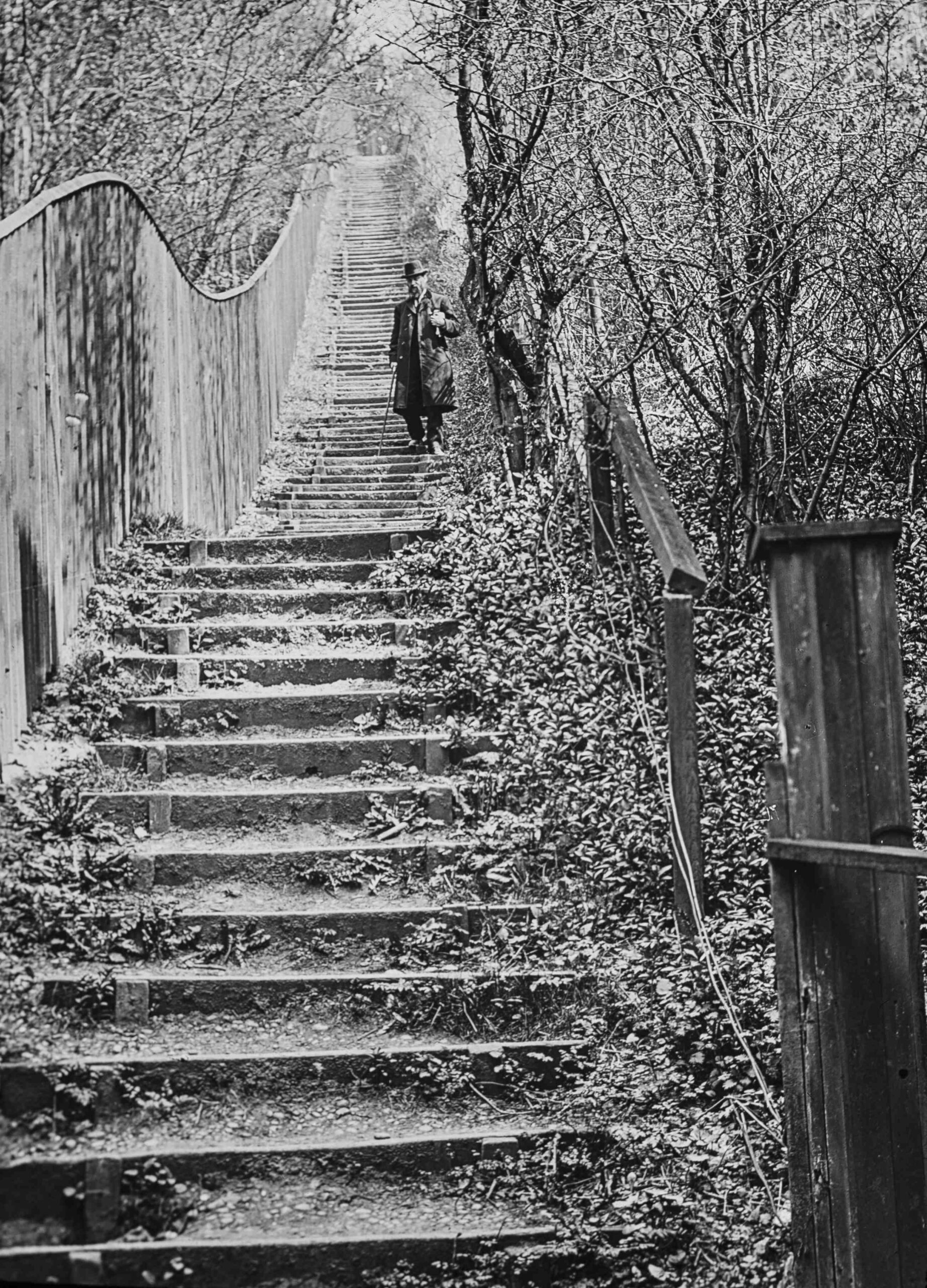
Then and now: Jacob's Ladder, Warlingham, Surrey
Use the slider below to see how this landscape has changed.
Image credits:
- SR OSS/PH5/B146, Open Spaces Society lantern slide collection, ‘Steps Warlingham, Surrey’.
- Photograph by Simon Webster, 13 March 2021.
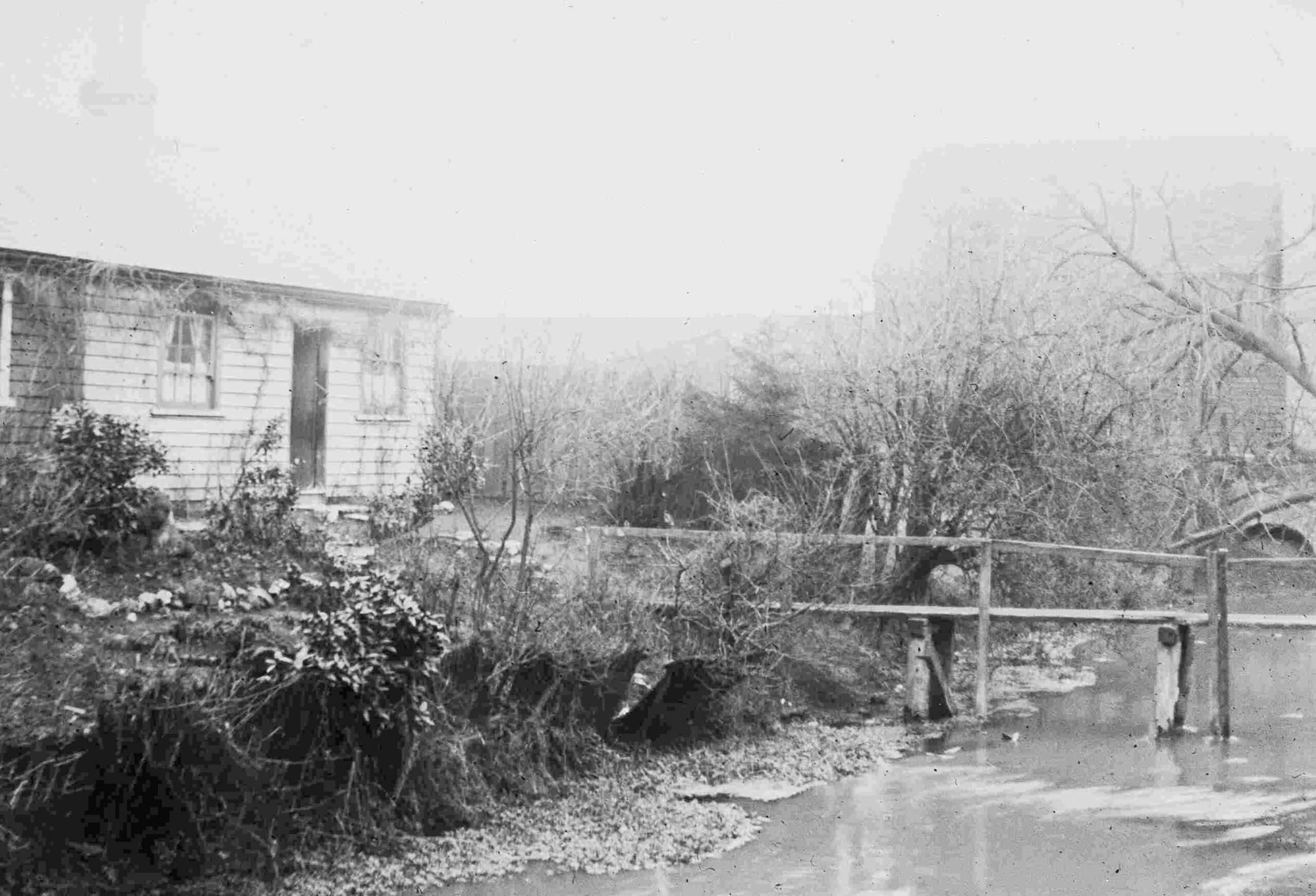
Then and now: Beddington, Surrey (near Wallis’s mill and snuff mill)
Use the slider below to see how this landscape has changed.
Image credits:
- MERL, SR OSS PH5/B100, Beddington, Surrey, near Wallis’s mill and snuff mill
- River Wandle cottages, Beddington, Surrey, photograph by Katrina Navickas, 14 February 2021
(Map link)